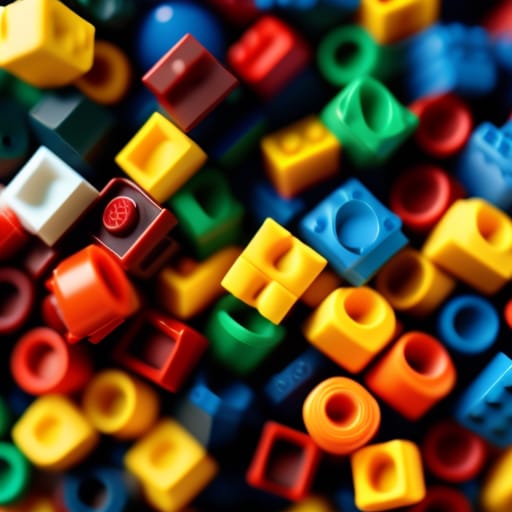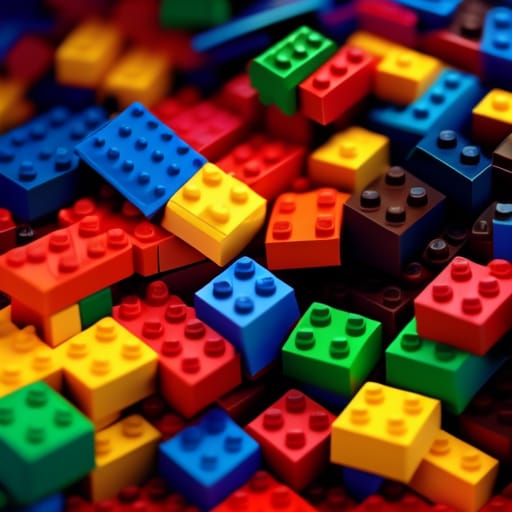Lego bricks have captured the imaginations of children and adults for decades. The simple plastic blocks provide endless possibilities for creative building and learning. This beginner’s guide will explore everything you need to know about Lego block sets and special pieces to make the most of these incredible toys.

A Brief History of Lego
- Lego was founded in 1932 in Denmark by Ole Kirk Christiansen. The company name means “play well” in Danish.
- Lego began by producing wooden toys. They experimented with plastic bricks after World War II and launched their automatic binding brick system in 1958.
- The patented stud-and-tube coupling system allowed bricks to lock together firmly, pioneering the modern Lego brick.
- Lego released Town Plan No. 1, their first town-themed box of Lego bricks, in 1961.
- Lego introduced minifigures in 1978, sparking new play possibilities.
- The first Lego sets with motors and gears came out in 1982, evolving into today’s Technic line.
- Lego Mindstorms launched in 1998, enabling computer programming capabilities.
- Today Lego produces over 3,600 different elements and sells blocks in over 130 countries.
Lego bricks have become globally beloved toys for encouraging open-ended creativity. Their educational benefits in STEM fields are widely recognized.
Understanding Lego Set Numbers
Lego assigns set numbers to all their blocks and kits:
- Standard sets – typical retail Lego, like vehicles or buildings. 4 or 5 digit numbers.
- Expert sets – more challenging kits for experienced builders. Mostly 4 digits starting with 1, 2, or 10.
- Ideas set – fan-created designs voted into production. 5 digits starting with 21.
- Minifigure series – individually sold minifigures. 5 digits starting with 71.
- Technic sets – models with technical functions. 5 digits starting with 42.
- Mindstorm sets – programmable computer robots. 5 digits starting with 97 or 85.
Knowing the prefixes helps identify set types when searching databases. Individual pieces also have element IDs.
Getting to Know Lego Pieces
Lego elements come in a myriad of shapes, sizes, and colors. Here are some of the most important pieces to know:
- Bricks – the basic building blocks. They have different dimensions.
- Plates – flat Lego pieces in various sizes.
- Tiles – like plates but with smooth tops that can’t hold other pieces.
- SNOT bricks – “studs not on top” pieces with side studs.
- Minifigures – small Lego people with swappable parts and accessories.
There are also many {bold|specialized pieces} like {bold|gears}, {bold|wheels}, {bold|windows}, {bold|hinges}, {bold|propellers}, {bold|flowers}, and more that come in sets.
Getting Individual Lego Pieces
While most people start off buying complete Lego sets, you can also buy individual pieces. This allows you to replace lost elements, get specialized parts, or customize kits.
Options for getting individual Lego pieces:
- Pick a Brick – browse and buy pieces on Lego’s website.
- Lego Stores – scoop elements out of bins at certified shops.
- BrickLink – peer-to-peer marketplace for buying used Legos.
- eBay – search for bulk lots of specific bricks.
Buying individual pieces can be more costly than kits but provides flexibility. Weigh if it’s worth it for your purpose.
Key Places to Find Lego Sets
Lego sets are produced in limited quantities and retire when sold out. Here are the go-to places to buy sets:
- Lego.com – browse all current sets directly from Lego.
- Lego Stores – certified shops carry hard-to-find sets.
- Target, Walmart, Amazon – major retailers often have sales.
- eBay – find old, retired sets from sellers.
- BrickLink – a marketplace with new and used Lego sets.
Check inventory regularly as popular sets sell quickly. Sign up for email alerts on your wishlist items.
Used Lego Buying Guide
Searching for Lego bargains? Here’s what to look for when buying used:
- Inspect element condition – Avoid cracked, chewed pieces. Normal scratches are OK.
- Check for warping – Heat can warp plates and bricks so they don’t hold together well.
- Feel for stickiness – Old, leaking glue can leave bricks sticky or jammed.
- Verify all Minifigure parts are included – helmets and accessories get lost easily.
- Count unique pieces – Sets should contain the exact elements listed.
- Complete instruction manuals are a bonus.
Buying used Legos from reputable sellers ensures you get quality elements for less.

Lego Display Ideas
Proudly show off your Lego artistry with these display ideas:
- Clear acrylic shelves – Perfect for showcasing models.
- LED lights – Illuminate transparent builds.
- Motorized turntables – Rotate your model for a complete view.
- Action poses – Position minifigures climbing, jumping.
- Themed backgrounds – Add landscapes suited to models like skyscrapers.
- Tell a story – Use multiple models to create a narrative.
With the right lighting and positioning, you can highlight incredible details in your Lego creations.
Top Lego Design Software
Access computer-aided modeling tools to enhance Lego planning with programs like:
- Lego Digital Designer – Official free Lego CAD software. Simple interface.
- Bricklink Studio – Design and render models. Access large part library.
- Bricksmith – Mac-based program with intuitive controls.
- Mecabricks – Online browser CAD tool with 3D viewer.
- Brickcontroller – Leading importer for Lego Mindstorms robot designs.
These programs allow you to build virtually before committing bricks to a physical model. Great for complex structures.
Common Lego Terminology
The Lego community has developed some unique terms and shorthand over the years:
- AFOL – An adult fan of Lego
- SNOT – Studs not on top
- POOP – Price of picking pieces individually vs set
- Purist – Builder who avoids painting/modding bricks
- Module – Standard horizontal unit of width in Lego structures
- Cheese slope – Wedge slope piece resembling a pizza slice
Learning the lingo helps you communicate clearly in Lego forums and marketplaces.
Top Lego Fan Communities
Connect with fellow Lego lovers online:
- Reddit – Active fan discussions on r/lego.
- Eurobricks – One of the oldest Lego forums since 1999.
- MOCpages – Share and discover custom My Own Creations.
- YouTube – Channels on builds, hauls, and techniques.
- Facebook – Groups for fans, collectors, and custom builders.
- Instagram – Lego photographers share artistic pictures.
The vibrant online Lego community offers inspiration and advice for novices to experts.
Benefits of Lego Therapy
Lego therapy leverages building blocks in therapeutic settings:
- Develops fine motor skills
- Teaches spatial awareness
- Encourages problem-solving
- Improves communication skills
- Fosters teamwork and sharing
- Reduces anxiety and stress
Studies show Lego therapy helps children with autism, ADHD, and other challenges.

Creative Lego Building Tips
Stretch your imagination with these tips:
- Look for inspiration in everyday items like furniture, architecture, and nature.
- Experiment with unusual color palettes beyond the usual bricks.
- Take models apart to understand advanced techniques.
- Find your niche – develop a specialty in buildings, robots, and sculptures.
- Collaborate with others online or at conventions.
- Make it modular – build segments that can be rearranged.
Thinking outside the box leads to amazing new Lego innovations.
Conclusion
Lego blocks offer endless avenues for fun and learning. Mastering the basics – from brick types to set numbers to building techniques – unlocks a world of creative possibilities. Check out Lego conventions, forums, and therapy programs to find a community as passionate about these toys as you are. With a bit of curiosity and imagination, you can build incredible new worlds, one brick at a time.
Frequently Asked Questions
What are the most popular Lego themes?
Some of the most popular current Lego themes include City, Creator Expert, Technic, Star Wars, Harry Potter, and Ideas. Classic themes like Space and Castle remain popular even if sets are retired.
How do I sort and organize Lego pieces?
Invest in sorting trays to easily organize your Lego collection. Sort by color, brick type, or purpose. Some enthusiasts even {bold|catalog} their collection digitally using spreadsheet {bold|inventory} systems.
Where can I learn advanced Lego building techniques?
Check out YouTube channels, blogs, and forums in the Lego community. Many builders share tutorials on techniques like {bold|SNOT} (studs not on top), texturing, sculpting, and more. The Beautiful Science book also showcases techniques.
Is it possible to identify all Lego elements by their {bold|element ID} numbers?
Enthusiasts have worked to identify the numbers on every Lego element, but some very old pieces have unclear markings. Software like Bricklink PartDesigner helps identify ambiguous elements.
What adhesive do I use for permanently gluing Lego pieces?
Avoid using Krazy Glue or Superglue. Lego brand glue or plastic cement like Loctite works best for permanently bonding Lego bricks.
Conclusion
Lego blocks offer endless avenues for fun and learning. Mastering the basics – from brick types to set numbers to building techniques – unlocks a world of creative possibilities. Check out Lego conventions, forums, and therapy programs to find a community as passionate about these toys as you are. With a bit of curiosity and imagination, you can build incredible new worlds, one brick at a time.